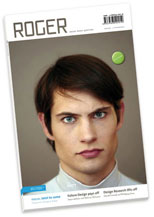
written by Lou Smith an Patrick Spingler
”Design… Interior design... Outdoor design… Innovation… Functionality… Exciting insights and inspiration… Products that meet the demands of modern lifestyle, quality and shaping… Combining the old with the new… Get in touch with completely new and inspiring ideas from the crème de la crème of international designers…” Sounds good, but what does it all mean? Spanning over 150 spots all across the city is, what its founder calls, “a ’Mecca’ for the design hungry and meeting point for the international design world” - Passagen 2007. After reading the brochure it seems as if you couldn’t walk for 500 meters in Cologne without running into one of Europe’s top designers these days. But is what’s behind the Passagen event really the high quality design proclaimed by many of the participants, or is it just a PR lady with a dictionary making mouthwatering promises from behind a curtain, like the wizard of OZ?
Obviously some of them had a hard time with their grammar school vocabulary lessons, because the guide is full of big words, which sound nice but are used incorrectly. For example, two designers presented a chandelier that they say fits into the field of so-called "Haute Couture" lighting. The chandelier was made of plastic, and a boring design, leaving us wondering what those lamps have in common with the unique handmade fashion pieces that bear the same name? Asking the designers, it became obvious that they didn't know either. But, hey, who cares? Haute Couture still sounds fancy, doesn't it?

The blurbs were also full of pre-formed opinions on the designs themselves. How can the author know that I will find a design inspiring before I even look at it?
Once again, the trend this year is reusing old designs from the mid 20th century. One showroom included stacking beds from the 60’s that were reproduced with new colors and finishes. The design is still great; the only problem is the sign on the showroom window reading “Modern Design.” Since when is 40 years ago modern? As far as design history books go the “modern” design movement happened more than 100 years ago. And they certainly can’t intend “modern” to mean current design.
Another example, a high-end kitchen producer brought back a design this year, which was, in its time, meant to be a functional kitchen for four. It takes only two square meters of the extensive showroom and, as the hostess was presenting the item, it became clear that it hardly functions and would barely be enough kitchen for one person nowadays. It must have been a bad year for kitchen design if they are recycling this kind of crap. Reproducing old designs is not necessarily bad, but they should at least be appropriate for the current market.
Many furniture designers are presenting the innovative idea of “modular” furniture systems, which allow the owner to use his own creativity to make combinations of furniture in an all-new way. The most avant-garde couch owners are experimenting with an L-shaped "get together zone" for their living rooms. Sorry everyone, you’ve been duped, have you ever noticed that modular furniture hardly ever gets moved into new configurations once it’s in the owners hands? It has been around for a long time, and it’s no longer new and interesting, just absolutely normal.

At the Design Post, a location which hosts 17 Passagen participants, there was not a single new product introduced for the event. 13 did not change their permanent exhibition at all for the Passagen. One store even admitted that the main reason for joining Passagen was peer pressure from the neighboring stores. If the showrooms are open all year round with no changes, then what’s so special about Passagen? Every year more and more permanent showrooms and stores want to join the Passagen and it seems to be only a question of time until IKEA joins as well. Just imagine Passagen visitors trekking to the outskirts of town to visit the extensive IKEA “showroom” in Rodenkirchen. It would be an odd sight, but surely Passagen curator Mrs. Voggenreiter would appreciate the profits from their participation.
This is exactly the problem with Passagen today. It has been taken over by permanent stores, most of which have barely changed a thing for the event itself. Asking one store about changes for Passagen, they replied that their showroom laid new green carpet, special for the event. Obviously, a great part of the exhibitors are just using the brochure to help visitors find their way to their retail locations. Maybe handing out Yellow Pages would do the job just as well. At least this way many visitors could be preserved from the harassment of those mind-numbing phrases and boring showrooms.
The furniture festival has become such a mess that many participating locations aren’t even relevant to furniture design anymore. A hotel participated in the event displaying only one piece of design in the lobby with no background information available or even anyone standing near it. It was obviously a gimmick to get visitors to stay with them during the event. The most irrelevant entry on the list was an authorized Apple computer dealer: The last time we checked, computers aren’t furniture at all.
For one week Cologne is full of orange Passagen banners, but so many are lacking something unique and new to back them up. It is nice to have a furniture design event in the city, but Passagen should take care that the content of the event does not become too full of crap. The event is nothing but its content, and if the content is recycled, non-functional, or irrelevant, the event will quickly become all of those things itself.

No comments:
Post a Comment